volume 3 1933-1934
| série: | Tarzan Sunday Pages |
| dessinateur / scénariste: | Foster Harold |
| éditeur: | Flying Buttress EO 1993 |
| genre: | Aventure |
| classement: | biblio1 |
| date: | 1993 |
| format: | cartonné avec jaquette |
| état: | TBE |
| valeur: | 30 € |
| critère: | ** |
| remarques: | third volume edited by NBM/Flying Buttress (NBM being America's first publisher of graphic novels since 1976, located at New York with imprints such as Flying Buttress Classics Library, Amerotica, Eurotica and ComicsLit) under the supervision of Bill Blackbeard out of a sery of 18 volumes, all being accurate reproduction of the Sunday Pages in their full colour and in full size, each volume has about 52 pages, n.b. the sources of these Sunday pages are mainly from the Los Angeles Times and from the Milwaukee Journal edited by UFS (United Features Syndicate) volume 3 1933-1934 with dust jacket from 24.9.1933 (133) to 16.9.1934 (184) = 52 pages drawn by Hal Foster based on the novel of Edgar Rice Burroughs mighty Prince Kamur of the barbarian Ibeks threatens Tarzan's life, but his lover, queen Nikotris of the rival Egyptian civilization lost in the jungle, sets herself between them, Tarzan tries to repay her by setting up a duel with Kamur to avoid all-out confrontation between the Egyptians and the Ibeks, neither of which like the idea of Kamur and Nikotris getting married... the volume includes following episodes (number of pages): the Egyptian Saga (continued) - Kamur the monster part two: 10 - child of Fire: 10 - the Pharaoh's command: 19 - Tarzan and the mysterious maiden part one: 13 1/ introduction by Robert Barrett about the life of Harold Rudolphe Foster (1892-1982) born in Halifax (Nova Scotia), history of Tarzan's edition by Joseph Neebe in comic strip, August 1929 the illustrated Tarzan Book No. 1 appeared, it is acknowledged now that Foster brought illustration to the comics pages, 1934 beginning of Prince Arn later renamed Prince Valiant when Foster cease Tarzan's work in 1937 2/ the story continuation of the Egyptian Saga >> p. 1-10-33 the history of the Ibeks' nation (enemies of the Egyptian nation) and of Kamur their giant tribe chief, Tarzan finds out that the mysterious black monster is in fact Kamur, prince of the Ibeks who was retained prisoner by the Egyptians and escaped with Nikotris who by now has fallen in love with Kamur >> p. 8-10 Kamur, the barbaric prince; Sheetah, the black panther which is not yet Tarzan's ally >> p. 29-10 fight between Tarzan and Kamur and Tarzan's cry of the bull ape arrival of the Egyptian and Ibek soldiers but Tarzan arranges peace between the two nations, however Tarzan and Nikotris are banished from the pharaoh Tutamken, during Kamur's sickness, his father Gornak wants to eliminate Nikotris who is saved again by Tarzan, the two escaped and took refuge in the jungle where they meet Hoteb, the Egyptian child who has also escaped from the Egyptian city in order to avoid being sacrificed by the Egyptian high priests >> p. 26-11 during a pursuit, Tarzan, with his giant strength, pulls his horse from the ravine up on the bank (Tarzan the mighty) >> p. 10-12 a new enemy: Basim the wild dog Kamur meets his friends again in the jungle, fight with the bull-ape Kabango "I am Kabango, I kill" but when defeating they surrender by saying "kagoda" which means I surrender in the ape language >> p. 24-12 the death-grip of Tarzan >> p. 31-12 Hoteb, the little Tarzan >> p. 31-12 up to 4-2-1934 pages of fights against apes and gorillas >> p. 7-1-34 the mad apes' dance of death dum-dum in the light of Goro the moon >> p. 21-1-34 Tarzan captured by the giant apes again being chased, Tarzan is confronted now with Sathor, the chief of a gang of Egyptians bandits >> p. 15-4-34 saved by the mighty Tantor the elephant >> p. 22-4- the elephants' fight against the bandits with their trunks weaponed with swords (an artful but curious warfare), after that, Kamur and Nikotris return to the Ibeks tribe while Tarzan brings Hoteb back to his family in the Egyptian city, but during this episode Tarzan comes again to grip with the Egyptian high priests >> p. 20-5 the cunning idea of Tarzan to elude the trickery deed with the sacred caskets arranged by the high priests it is the fight of Tarzan against Haithoreb the high priest >> p. 21-5 the house of death finally Tarzan succeeds in leaving the Egyptian land and arrives on a sea shore where he meets the desperate princess Mihrama, daughter of the sultan Palazar who is taken as a slave by moorish pirates, Tarzan rescues the princess and after escaping also to the sultan Bahdin in Sanabar, both take refuge on a strange vessel carrying wild jungle animals closed in cages (the floating menagerie!) >> p. 19-8 the duel of Tarzan with the giant wrestler Hasan >> p. 2-9-34 Tarzan opens his way armed with a huge scimitar >> quite a good volume drawn by Foster (making also the scenario?), full of action with a colourful painting, Foster has by now reached his routine style of drawing that will however even improve later on; the story with the Ibeks and with Kamur+Nikotris is particularly interesting following the various events encountered and these two characters will reappear in 1941 drawn by Hogarth in the episode of Tarzan against Dagga Ramba Information - mangani = language used by the great apes - tarmangani = white-skinned like Tarzan - gomangani = black-skinned, dark great ape - kagoda = surrender (during a fight) - numa = lion, tantor = elephant |
| couvertures: | 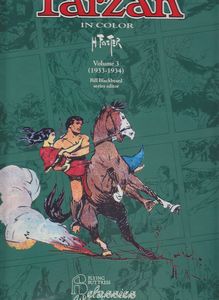 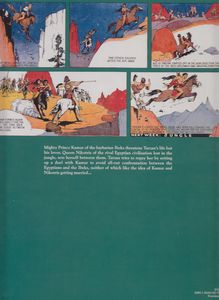 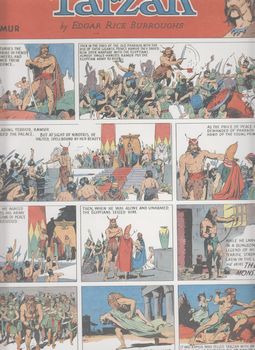 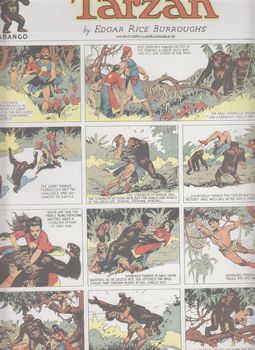 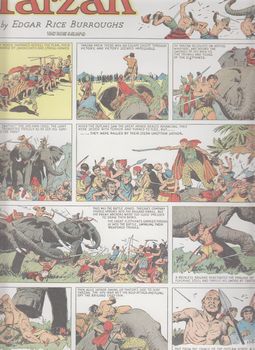 |
Copyright 2008 - 2025 G. Rudolf
